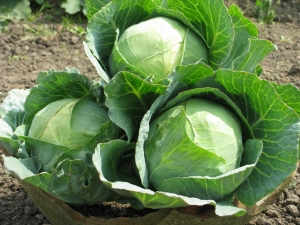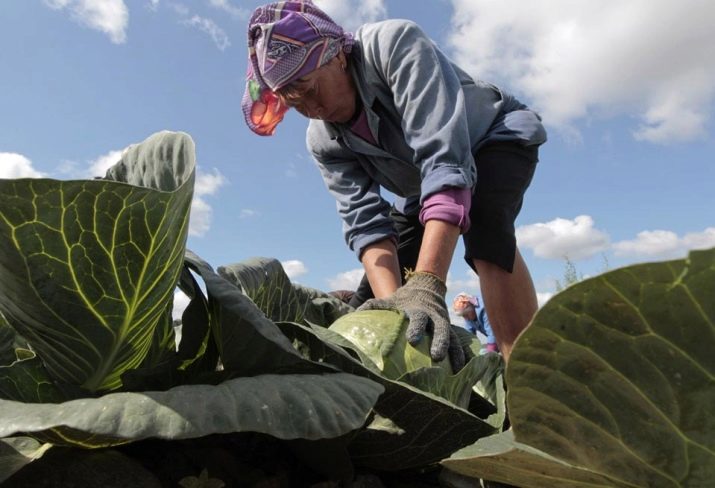Characteristics of a grade of cabbage "Atriya"

Cabbage is the kind of vegetable that almost every vegetable grower grows.It is represented by a large variety of varieties, each of which has its own individual characteristics. One of the most high-yielding varieties is cabbage "Atria" F1. With proper care this white cabbage pleases with a high yield in the form of tasty and juicy fruits.
Variety description
This variety is bred in the Netherlands and is suitable for fresh consumption or for storage. The description of this culture attracts the attention of not only summer residents, but also farmers who grow cabbage on a large scale. The white cabbage "Atria" F1 is a medium late variety, which requires about 150 days from the moment of emergence for full ripening. Heads of rounded shape, the weight of which can reach 8 kg. The most pronounced taste becomes during storage, since it is during this period that the vegetable is filled with juice and flavor.
Advantages and disadvantages
Like any other culture, cabbage "Atria" has its advantages and disadvantages.
Its positive qualities include:
- excellent taste;
- dense head structure;
- resistance to rotting and cracking;
- long shelf life;
- proper maturation.
This vegetable is completely unpretentious to the climatic conditions, thanks to which it perfectly adapts to almost any soil. The characteristic of cabbage varieties "Atria" indicates its resistance to various diseases and pests. Due to the dense structure of the head, they do not lose their original qualities during transportation. Simultaneous ripening of cabbage contributes to their timely collection and processing. It has a very presentable appearance, thanks to which it is in great demand among consumers.
There is no disadvantage as such cabbage of this variety, except its need for moisture. Therefore, for the full growth of this variety is to provide the necessary level of moisture. In addition, it is best to plant this crop on open and spacious grounds, where there is no shading.
Planting and care
To grow healthy seedlings and get a good harvest, it is necessary to properly prepare the soil and seed material. The seeds of the variety Atria are best planted in seedlings in April. Before sowing, the seed material is quenched and tested for germination. For this, the following actions are taken:
- seeds for 15 minutes are placed in water with a temperature of at least 50 degrees;
- after the time expires, the seeds are moved to cold water for another 5 minutes;
- after that, they are transferred for 12 hours to a pre-prepared composition of 1 liter of water and 5 grams of nitroammofoski;
- then the seeds are washed in clean water and hardened for 24 hours in a cold room, the air temperature in which is 1-2 degrees.
After that, the seeds are well dried and prepared for planting in the soil. The ideal option is a composition of peat, sand and sod land. 17 grams of superphosphate must also be added to a bucket of such soil.
The tanks where the Atria seedlings will be planted should have a height of not less than 6 cm. Grooves are made in the ground within 1 cm into which the seeds are planted. In a room with a temperature of 20 degrees, the first shoots appear after 7 days. Low air temperatures can cause plant death.
The seedling needs a mandatory hilling, which is favorably displayed on its growth.
Periodically it is necessary to carry out feeding seedlings. To do this, you can make a solution of 1 liter of water and 0.5 tablets of mineral supplements and spray them with cabbage. In general, the seedlings are fed 4 times.
- 1st. Produced 20 days after disembarkation using a solution of 10 liters of water and 2 tbsp. l drug "Effecton".
- 2nd. Performed after another 10 days using a composition of 10 liters of water, 1 tbsp. l Kemira and 0.5 grams of bird droppings.
- 3rd. It is carried out in June using a solution of 10 liters of water, 20 grams of potassium sulfate and 18 grams of superphosphate.
- 4th. Produced in August using 10 liters of water and 15 grams of nitrophoska.
Regular watering contributes to the cultivation of good seedlings. For 14 days, seedlings planted in open ground, watered every three days. Further watering is recommended once a week. After 30-35 days, seedlings reach a height of about 10 cm, the stems of which already have 2 pairs of leaves.
In the process of selecting a site for growing cabbage “Atria”, it is necessary to consider which crops grow in the neighborhood. This variety goes well with cucumbers, potatoes, tomatoes, dill, strawberries and grapes.
It is recommended to plant seedlings in cloudy weather or in the evening in order to protect young plants from the adverse effects of sunlight.
Harvesting
The harvest time for the Atria cabbage is early November. After cutting the cabbages are placed in boxes or special storage space. At the same time, the cabbage heads should be laid up with stumps so that these vegetables are juicy and retain their original qualities. The weight of one head of Atria cabbage can reach 8 kg, due to which the average yield per hectare is 1 ton.
Experienced gardeners are not advised to leave the cut cabbage on the ground, so it is best to lay a film on it. Leaving the cabbage in the fresh air for some time in order to plant the upper leaves, you can ensure it is well preserved.
Diseases and pests
Like any other crop, cabbage "Atria" is susceptible to the effects of various diseases and pests. To get a good harvest, you need to timely detect the cause of damage and take appropriate measures.
The most common diseases of cabbage "Atria" are several.
- Vascular bacteriosis. Manifested in the form of yellow leaves, edge clarifications of cotyledons, blackened veins and brown spots on the petioles. May occur at any stage of cultural development. To prevent the appearance of this disease will help a solution of 5 liters of water and 10 grams of "Trichodermin", in which just before planting it is worth wetting the roots of seedlings. If the disease is actively developing, then it is necessary to spray the cabbage with a 0.25% solution of the drug "Fitolavin".
- Kila. Manifested in the form of sluggish and weakened stems with the presence of yellow leaves and small forks. Plants prone to this disease develop slowly and have noticeable swellings on the roots. For prophylaxis, 500 ml of a 5% solution of colloidal sulfur should be poured into each well immediately before disembarking. For medicinal purposes, the cabbage is treated with a solution of 10 liters of water, 40 grams of the drug "Chom" or 1% solution of Bordeaux mixture.
- Blackleg. Manifested in the form of blackened stems, which subsequently wither and dry. For plant prevention, it is worth treating with a 0.2% solution of Fitosporin. With the active development of the disease, seedlings must be treated with a composition of 100 ml of water and 1 tsp. soda
- Fusarium Manifested in the form of yellowed and wilted leaves, as well as pronounced deformation of the heads. Damaged seedlings are removed from the site, and the surviving plants are sprayed with Benomyl fungicides.
- Turnip Mosaic. Manifested in the form of light green spots on the leaves, which under the influence of the disease fade and fall off. It is considered the most difficult disease of this variety, with the appearance of which all the seedlings are completely removed from the site. To prevent this disease from occurring, seeds must be disinfected immediately before sowing.
It is important to know the most famous pests of the "Atria" variety.
- Cruciflo flea. Small insects in the form of fleas, feeding on cabbage leaves, cause great harm to the fruit. For the prevention of seedlings sprinkled with wood ash or tobacco dust. You can get rid of the excessive activity of these pests by spraying the plants with a solution of 10 liters of water and 1 tbsp. l 70% acetic essence.
- Slug. Pests such as slugs feed on cabbage leaves, leaving holes in them.As a preventive measure between the rows of cabbage, it is recommended to disperse mustard powder, which has excellent protective properties.
With a strong activity of pests it is recommended to decompose the drug "Snezneed" between the rows.
- Cabbage whitefish. It is a caterpillar, emerging from the lay of eggs of white butterflies. Gnawing cabbages, they cause them great harm and spoil the presentation. For prevention, you can plant a number of flowers marigolds, which with their pronounced aroma frighten off these pests.
All these diseases and pests cause some harm to Atriya cabbage. Therefore, in order to get a good harvest, it is necessary to provide this crop with all the conditions for full growth and development.
Reviews
Numerous reviews indicate that Atria cabbage has an unsurpassed taste and is characterized by a long shelf life. This variety is great for canning and fermentation. Experienced gardeners appreciate this crop for its juicy and massive fruits, whose taste is noticeably improved directly during storage. In addition, the cabbages do not lose their original appearance, so they tolerate long-term transportation.
The leaves of Atria cabbage are quite resilient, which prevents its cracking and deformation. In general, the variety is unpretentious to care, so that it can be found not only on large fields, but also on home beds.
The seedling grows well on almost any soil, and with proper care it gives high yields and pleases with its excellent taste.
In the next video, see the review of cabbage varieties "Atria"









































